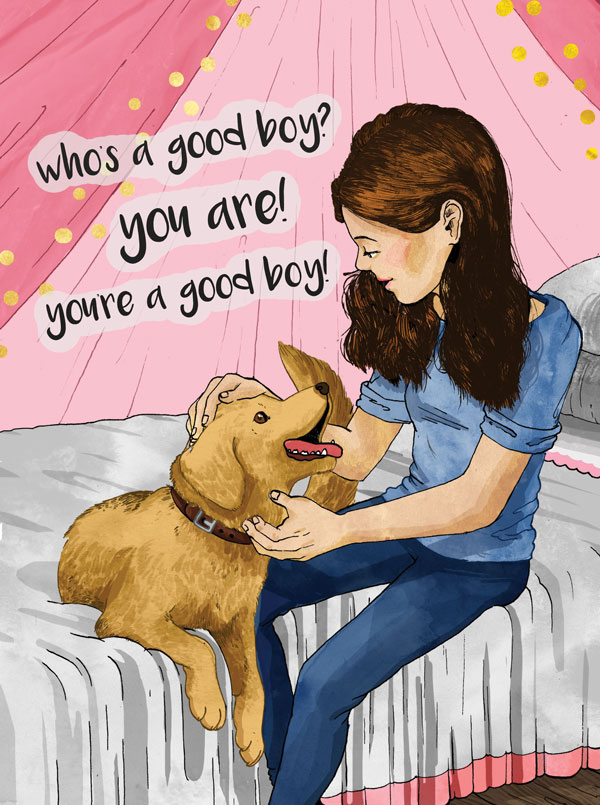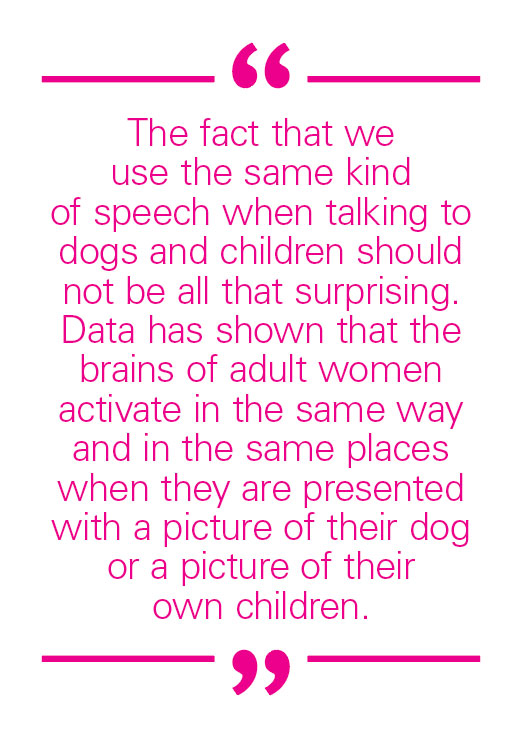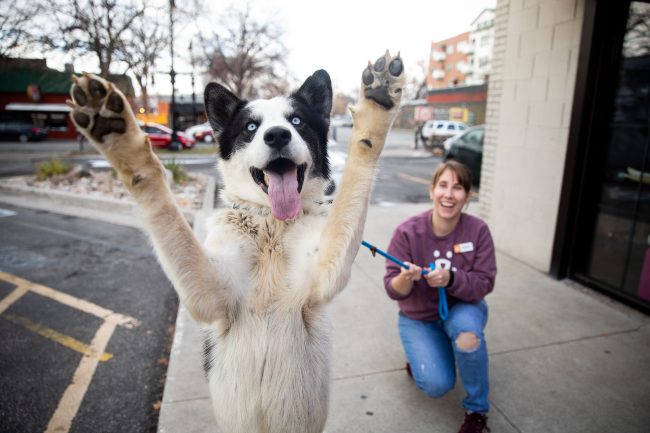

Chances Are You Baby-Talk to Your Dog… But Does He Care?
Dog-speak. We all do it, but a new study shows there's good reason to baby-talk to your dog.
When I walked into the room I heard a woman speaking to someone. She was saying “You are so adorable! Yes you are! You are. You are so sweet that you make sugar seem sour. Don’t you? Don’t you?” She had pitched her voice quite high and was delivering the words in a melodious rhythm. Before I even turned to look at her, I knew that she was speaking to either a baby or a dog. When I did look in her direction I saw that she was holding a cream-coloured Pomeranian to whom this outpouring of affection was directed. So natural is this impulse to change one’s voice and speech patterns when addressing babies, puppies or dogs that she probably didn’t even realize that she had veered from “normal” human speech into the specific dialect commonly used for the “babies” in our lives.

Back in the 1980s, psychologists Kathy Hirsh-Pasek and Rebecca Treiman (then at the University of Pennsylvania) were able to show that the language we use when we are talking to dogs is very similar to Motherese. Technically it should be called dog-directed speech, but instead they playfully labelled this form of language “Doggerel.”
The fact that we use the same kind of speech when talking to dogs and children should not be all that surprising. Data has shown that the brains of adult women activate in the same way and in the same places when they are presented with a picture of their dog or a picture of their own children.
Dog-directed speech or Doggerel is certainly not the normal language one would use around other adults. When we are talking to our canine companions our sentences are much shorter. Strangely, we also ask twice as many questions of our dogs than we do of humans, even though we really don’t seem to expect any answers. These questions are mostly trivial social exchanges rather than information seeking, such as, “How do you feel today, Lassie?” A lot of these queries are in the form of “tag questions,” which is where one makes an observation and then turns it into a question at the very end. An example of this would be saying, “You’re hungry, aren’t you?” When speaking to our dogs we are also 20 times more likely to repeat ourselves than when we talk with adult humans. These repetitions can be exact copies, partial repetitions, or some form of rephrasing. An example of rephrasing and repeating would be “Lassie you’re a good dog. What a good dog you are!”
Recently, a research team headed by Tobey Ben-Aderet of the Psychology Department at Hunter College in New York City asked the obvious question—Does it matter at all to dogs that we are speaking to them in Doggerel rather than in normal speech tones? The report of the team’s findings was published in the Proceedings of the Royal Society.
Here’s how they set about determining the answer. To get samples of Doggerel, the researchers recorded the voices of women speaking to photographs of dogs. These photographs included a puppy, an adult dog, and an older dog. To get a sample of normal human speech, they had the same women speak to the researcher. In all cases the women repeated a short script which was, “Hi! Hello cutie! Who’s a good boy? Come here! Good boy! Yes! Come here, sweetie pie! What a good boy!”
When the researchers analyzed these voice recordings they found that the women used Doggerel when speaking to all of the dogs, regardless of their age. In all instances their voices were pitched higher than in normal human adult-directed speech. The only difference that the investigators could find is that when talking to puppies, the women pitched their voices even a bit higher than they did for the older dogs. In other words, in these women’s eyes all dogs were baby-like and so they used baby-talk when speaking to them.
To test whether speaking in Doggerel affected the dog’s behaviours, the researchers placed a high quality speaker in the room with the dog. They then played back the recorded clips from the same woman speaking in Doggerel and then using normal speech and videotaped the dog’s reactions to the voice coming out of the speaker. Specifically, they looked at things like whether the dog looked at or approached the speaker, or whether he barked or whined when the speech sample was played, and so forth.
What they found was the puppies had the greatest reaction to hearing Doggerel. The overall amount of reaction decreased as the dogs grew older, until, with the oldest dogs in the test group, the reactions to normal speech or Doggerel were about the same. What seemed to be most important in determining the response of the dogs was the pitch of the voice. This was especially true for the puppies whose responses to Doggerel steadily increased as the pitch of the woman’s voice became higher and higher.
The data clearly showed that when we use baby-talk with puppies, it catches their attention and gets them more involved. But why didn’t Doggerel have more of an effect on the adult dogs? The experimenters suggest that this may be because the voices used in the experiment were from people the dogs were unfamiliar with, hypothesizing that perhaps, as dogs grow older, they become more selective as to whose voices they pay attention to. That means that when they are adults they are more likely to respond to the changes in inflection and tone coming from their owner or familiar voices.
This suggestion fits my own experiences very well. For example, when my dearly loved Nova Scotia Duck Tolling Retriever, Dancer, was in his fifteenth year of life, and had slowed down considerably because of arthritis, one sure way to get him up and moving and his tail wagging was to pitch my voice as high as I comfortably could and speak to him in Doggerel: “Who’s a good dog? Dancer’s a good dog. You are, aren’t you? I could just love you to pieces, couldn’t I?” Of course, this conversation would take place in private since there are still some people out in the world who view such verbal interactions with dogs as sheer nonsense, an indication of lower intelligence or the sign of the early onset of dementia. But now we have scientific evidence to show that they are wrong. So go ahead and baby talk to your dog. I’m sure you already do, but now you have good reason to!
Join the newsletter and never miss out on dog content again!
"*" indicates required fields
By clicking the arrow, you agree to our web Terms of Use and Privacy & Cookie Policy. Easy unsubscribe links are provided in every email.






